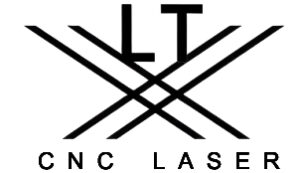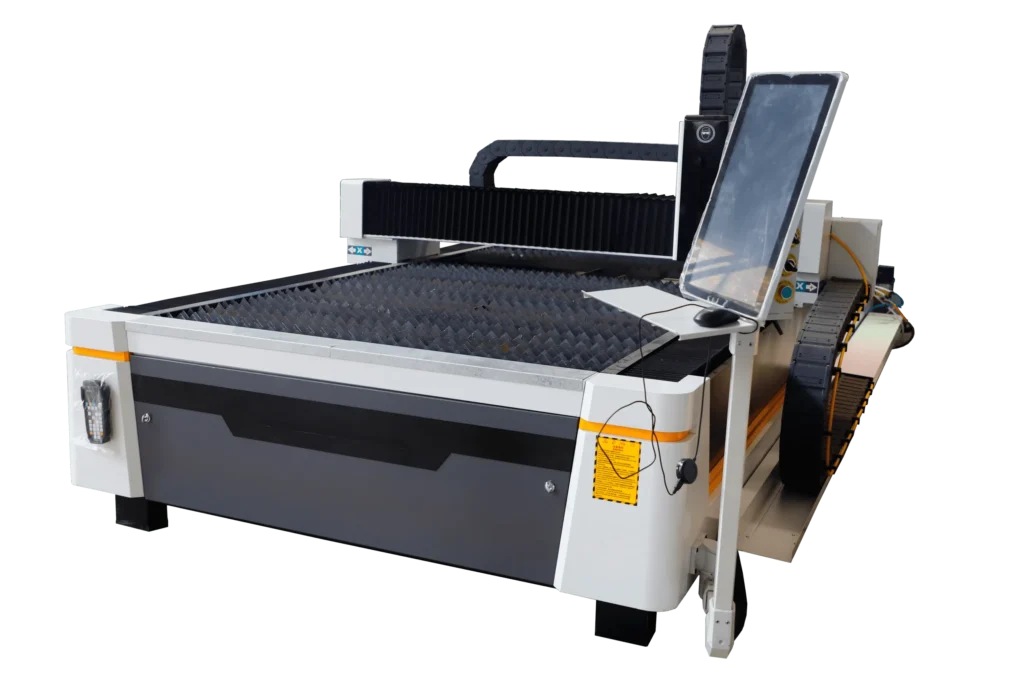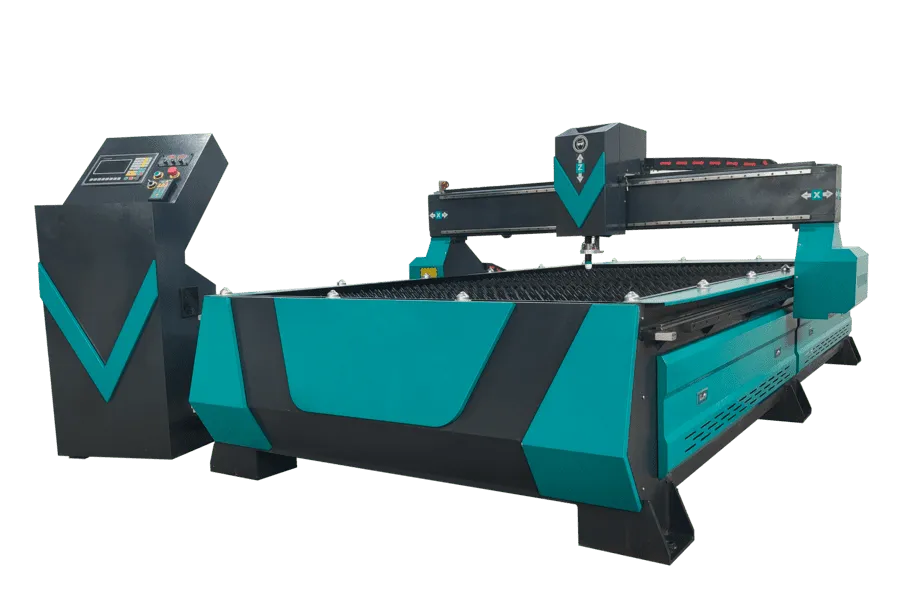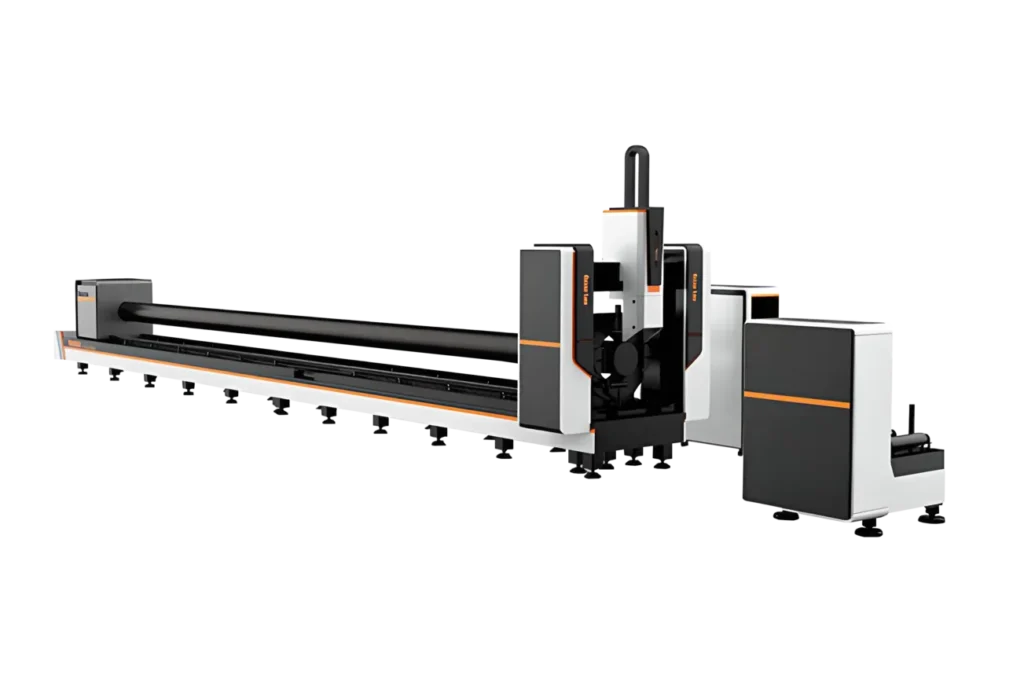Working Principle and Core Advantages of Laser Pipe Cutting Machines
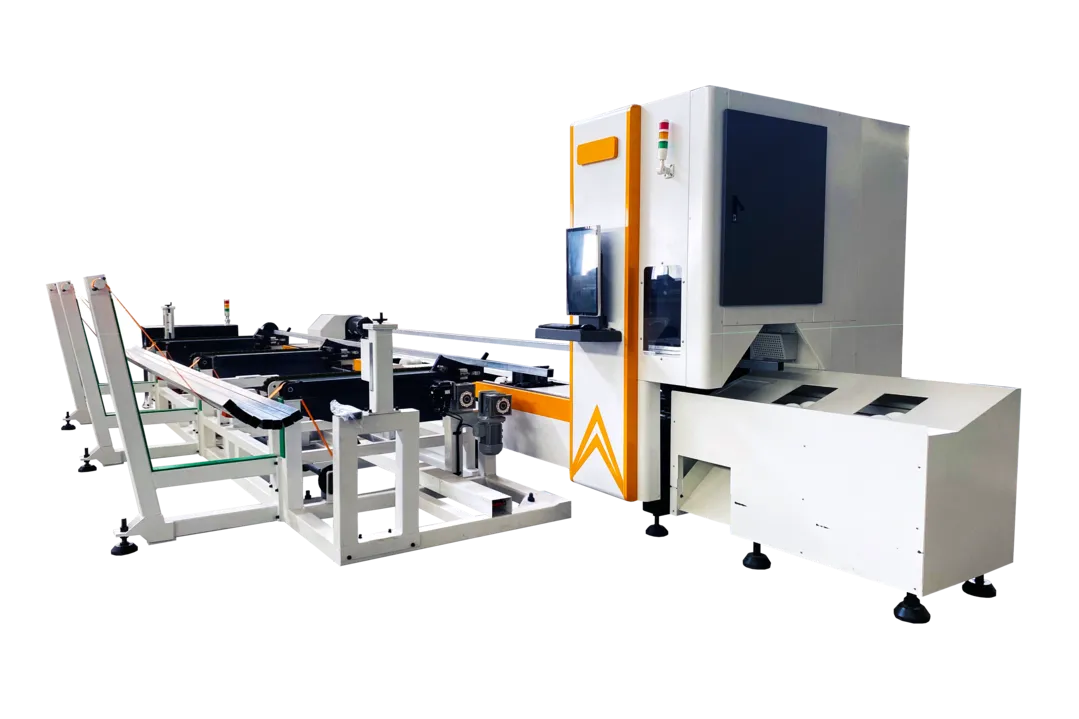
Laser Tube Cutting Machine
Working Principle: Laser pipe cutting machines utilize a high-power-density laser beam focused on the pipe surface, causing local instantaneous heating to melting or vaporization, and achieving cutting with the assistance of blowing gas. Similar to flat sheet laser cutters, pipe cutting machines typically employ a chuck rotation method: one end of the pipe is fixed and driven to rotate by the rotating chuck, while the laser head moves axially and radially along the pipe to cut the pipe wall (1). Most cutting machines are equipped with two or three CNC axes; the laser head remains essentially stationary (moving up and down), achieving full-directional cutting of the pipe through chuck rotation and feeding (3).
Core Advantages: Laser pipe cutting is non-contact processing, applying no mechanical stress to the workpiece, with an extremely small heat-affected zone, minimizing material deformation (4). With precise computer numerical control (CNC), pipe cutting machines achieve high precision and repeatability, with contour dimensional tolerances reaching ±0.05mm (5). The laser beam focus is extremely small, resulting in narrow kerfs and smooth, burr-free cuts, eliminating the need for secondary deburring (6). Furthermore, laser cutting vaporizes material within the kerf, eliminating tool wear. One machine can complete multiple processes such as sawing, drilling, slotting, and punching. Complex shapes and holes/slots can be cut in a single clamping, significantly reducing process changeover time (7). Laser pipe cutting machines also embody high intelligence: equipped with specialized control systems and nesting software, they can directly read CAD drawings or automatically generate cutting patterns based on parameters input via the operation interface. This enables on-the-fly design modifications and rapid production changeovers, offering high flexibility (8). Some advanced models also integrate high-precision sensors, automatic focusing, and measurement functions, enabling automatic weld seam recognition and avoidance, intelligent focus adjustment, and interfacing with MES (Manufacturing Execution Systems), allowing for near 24/7 unmanned operation (9).
Efficiency Advantages: Compared to traditional manual or semi-automatic pipe cutting, laser cutting is fast and capable of continuous long-term operation. Manual sawing or punching is not only slow but also requires concentrated operator effort and periodic breaks. Laser equipment, while maintaining high precision, can operate continuously at high speeds for hours or even uninterrupted production, ensuring long-term stable operation as long as cooling conditions are met (10). Overall, laser pipe cutting machines significantly improve the quality and production efficiency of pipe processing due to their high precision, non-contact nature, and intelligent automation (11).
Applicable Industries for Laser Pipe Cutting Machines
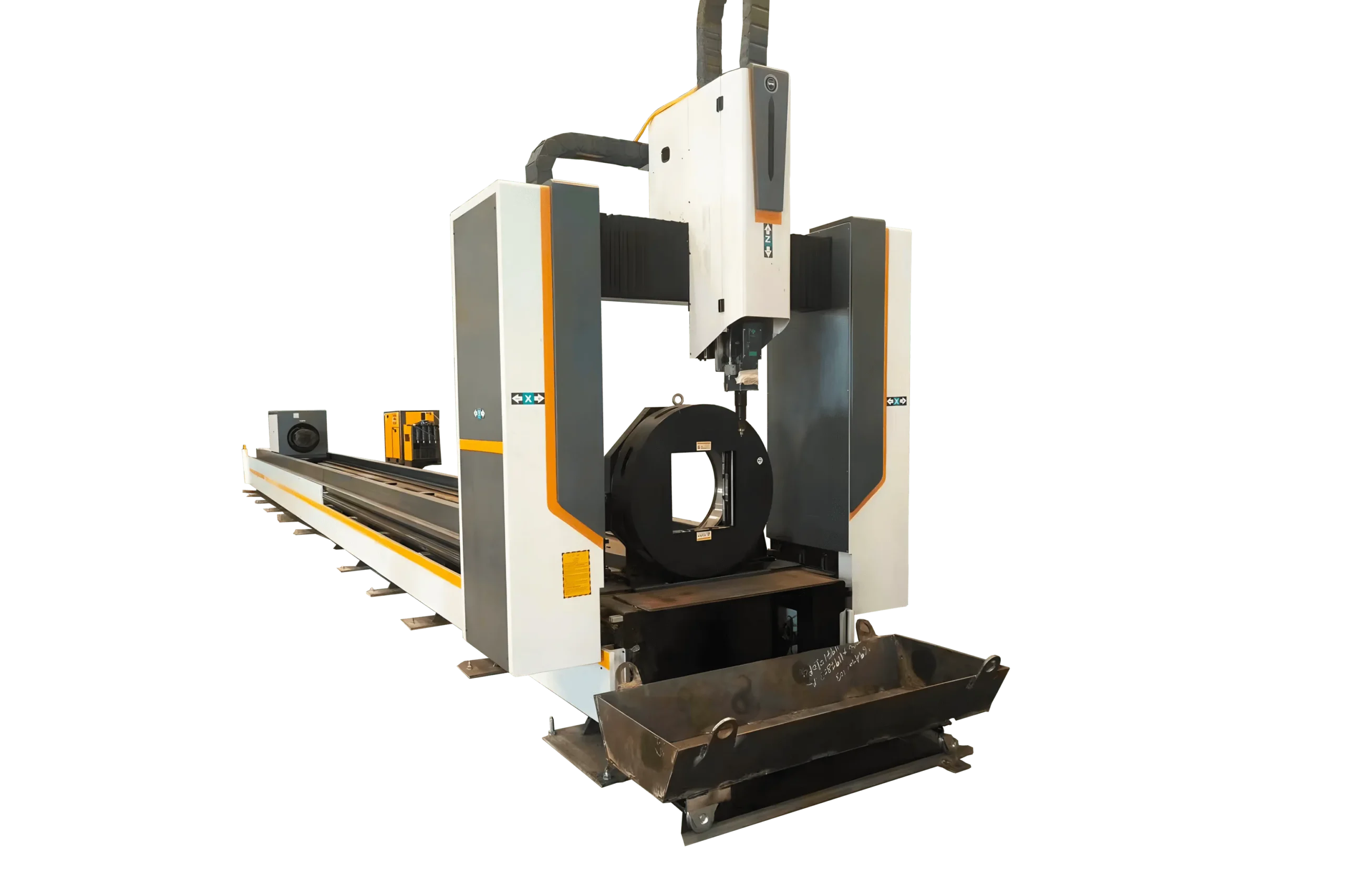
Big Scale Laser Tube Cutting Machine
Laser pipe cutting technology, due to its flexibility and efficiency, is now widely used across multiple industries. Traditionally focused on metal pipe processing, it now also involves cutting non-metallic materials such as plastic pipes (12). In manufacturing, laser pipe cutting machines are found wherever pipe components are involved:
-
Automotive Manufacturing: The automotive industry heavily utilizes metal pipes, such as exhaust pipes, frames, seat frames, and shock absorber housings. Laser pipe cutters can precisely cut steel pipes for automotive use, not only for simple cutting and blanking but also for processing complex notches and irregular holes, meeting the requirements for lightweight automotive components and high-precision assembly (13). For example, Golden Laser provided an automated laser cutting production line for crossbeams for a renowned car brand, achieving linkage between pipe notch cutting and robotic bending processes, significantly improving the processing efficiency of automotive frame crossbeams (14).
-
Metal Furniture and Architectural Decoration: Modern furniture (e.g., metal tables, chairs, bed frames, shelves) widely uses metal pipes. Laser pipe cutting technology has penetrated the furniture and interior decoration fields, where its exquisite cutting and notching techniques inspire new designs for metal furniture (15). Traditional processes require multiple steps like sawing-punching-bending-deburring, while laser cutting completes complex pattern cutting and hole opening in one step, with smooth edges requiring no grinding, greatly shortening the production cycle (16). At the same cost and capacity, laser equipment can process a wider variety of furniture pipe components, ensuring precise dimensions and high consistency for each product (17). This enables the provision of diverse, personalized furniture products to meet consumer demands for varied designs, while reducing mold costs and inventory pressure (18). In architectural decoration, laser pipe cutters can produce stair handrails, railings, curtain wall brackets, etc., excelling particularly in cutting pipe components with complex patterns, enhancing the aesthetics and customization level of building metal elements.
-
Engineering Machinery and Steel Structures: Construction scaffolding pipes, steel structure trusses, pipe piles, and bridge structural components heavily use steel pipes. Laser pipe cutting machines can efficiently blank large quantities of thick-walled pipes. Especially when cutting assembly holes and slots on steel structure joints, the precision and flexibility of lasers far surpass traditional flame cutting or drilling methods. For instance, in bridge and tower manufacturing, profiles like H-beams and channel steel are common. Advanced five-axis laser pipe cutters can cut large pipes and profiles up to 800mm in diameter and 12m in length. This guarantees precise assembly of steel structural parts, reducing on-site grinding and adjustments, and boosting construction efficiency.
-
Fitness Equipment and Sporting Goods: Fitness equipment (e.g., horizontal bars, fitness racks, equipment frames) and stadium facilities consist largely of metal pipes. Laser pipe cutting helps manufacturers rapidly produce customized equipment in batches. For example, a large Russian sports equipment manufacturer introduced a 1000W fiber laser cutter to cut various round and square tubes for manufacturing gymnastics equipment, goal frames, etc., enabling product diversification while ensuring cutting quality and precision. Laser equipment easily switches between different equipment drawings via CNC programs, adapting to multi-variety, small-batch production models, greatly enhancing the manufacturer's customization service capabilities.
-
Medical Devices and Agricultural Equipment: Medical beds, wheelchairs, hospital carts, and other medical devices, as well as agricultural machinery (e.g., seeder frames, harvester structural parts, greenhouse frames), also extensively use steel pipes. These industries demand high reliability and consistency for pipe fittings. Laser cutting provides precise pipe processing solutions; burr-free cut surfaces ensure subsequent welding quality, improving product safety and lifespan. In recent years, many agricultural machinery manufacturers have begun upgrading equipment by introducing fiber laser pipe cutters to achieve digital processing and automated production. For example, a French agricultural machinery factory adopted Golden Laser's P3080A pipe laser cutter to form an automated production line. This not only reduced operational difficulty and improved production efficiency but also enhanced the processing accuracy of parts and overall machine quality, increasing the durability of agricultural equipment in harsh environments (22).
In summary, laser pipe cutting machines have a very wide range of applications, including but not limited to automobiles, furniture, construction, fitness equipment, medical, and agricultural machinery. Any field involving the processing of metal or non-metal pipes can benefit from laser pipe cutting technology to achieve efficient production and product innovation.
Efficiency and Precision Comparison with Traditional Processing Methods
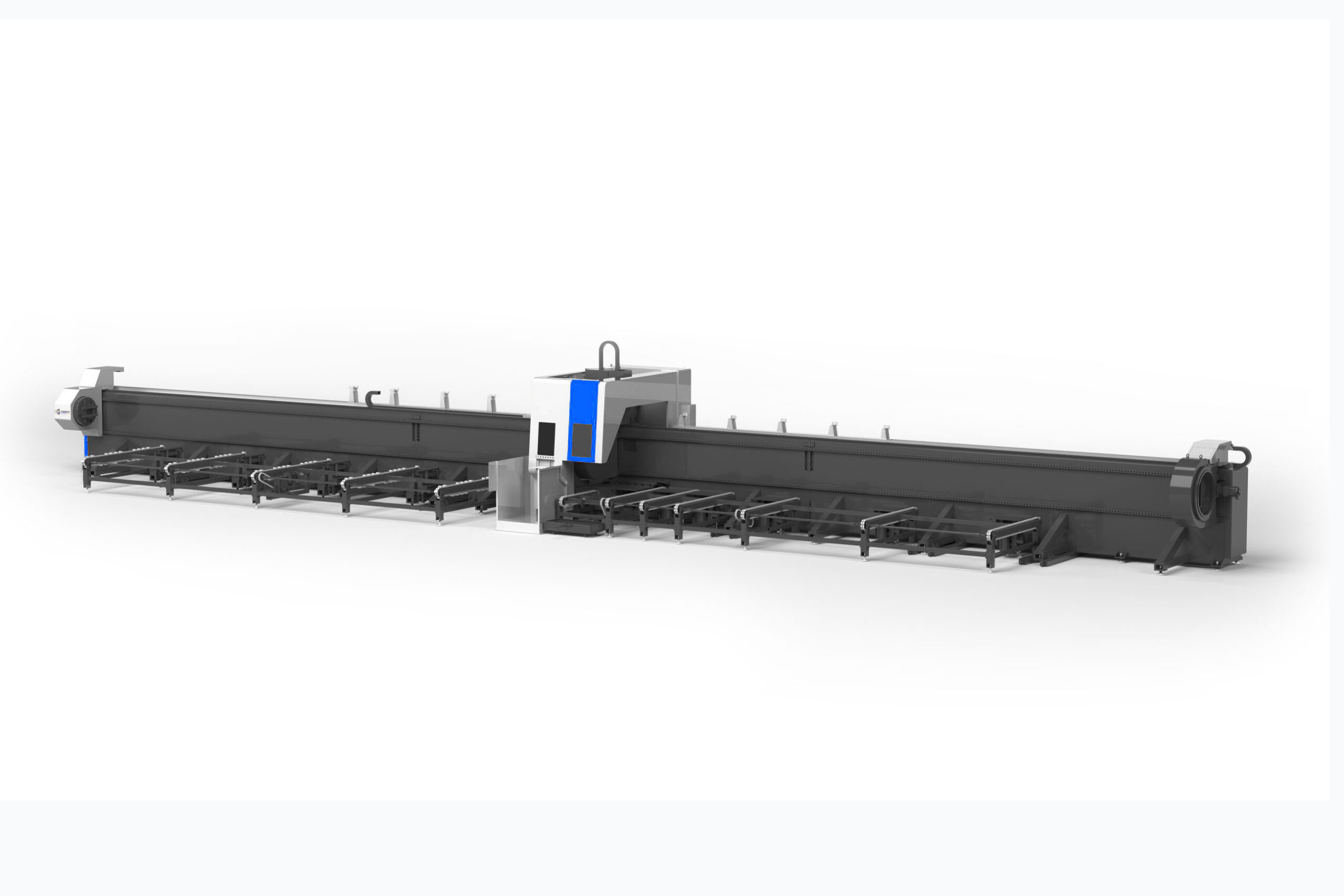
Three Chucks Big Size Laser tube Cutter
Compared to traditional processing methods like sawing, punching, and drilling, laser pipe cutting technology holds significant advantages in efficiency, precision, and process complexity:
-
Process Integration, Multi-functional Machine: In traditional manufacturing, processing pipes often requires multiple machines: a saw for blanking, a drill press for holes, or a punch press for slots, followed by manual deburring and trimming. Laser pipe cutting machines concentrate these processes upfront; a single clamping allows completion of blanking, hole opening, slotting, engraving, and more. For complex pipe fittings, laser cutters handle streamlined irregular holes or contours without needing extra molds or tools, eliminating tool-change downtime. This process integration drastically shortens the production flow, reducing equipment footprint and process changeover time.
-
Precision and Quality: Laser cutting, controlled by CNC programs, achieves repeat positioning accuracy up to ±0.03mm, far surpassing manual or mechanical cutting. Laser kerfs are very narrow with smooth edges, allowing parts to proceed directly to welding and assembly without secondary processing. In contrast, saw blade cutting often leaves burrs and thermal distortion requiring grinding; punching causes burrs around holes and material stress concentration, and mold wear affects accuracy. Being non-contact, laser exerts no squeezing force on the pipe wall, making it particularly suitable for thin-walled pipes and high-precision products. For example, lasers can cut dimensionally precise round holes in thick-walled pipes without overheating and melting the hole edge, something mechanical drilling struggles to achieve (24).
-
Efficiency Improvement: In batch production, the high-speed motion and automation advantages of laser pipe cutters become even more pronounced. A traditional saw might take minutes to cut one steel pipe with manual loading/unloading, whereas modern laser pipe cutters equipped with automatic loaders can continuously feed and cut. Multiple pipes can be loaded in bundles, and the machine cuts them sequentially without stopping. Furthermore, the speed of laser cutting complex contours depends on the complexity, unlike manual methods requiring multiple tools and steps. If the same pattern requires multiple windows and holes/slots on the pipe wall, laser can form them in one operation (15), while traditional methods require sawing, then drilling, milling slots, etc., cumulatively taking much longer. Human operators often trade off between precision and speed when using mechanical cutting, while laser equipment can maintain high-speed precision operation for extended periods. For instance, a typical fiber laser pipe cutter can achieve positioning speeds of 90 meters/minute, with chuck rotation speeds up to 105 RPM. Under full automation, its capacity far exceeds manual cutting (27).
-
Processing Complexity: Achieving complex geometric patterns on pipes is often very difficult with traditional methods. For example, cutting curved patterns on a pipe wall might require expensive custom molds for stamping or step-by-step machining using CNC milling machines, processes that are time-consuming and wasteful. Laser cutting machines can directly "draw" on the pipe based on CAD graphics, producing complex pierced patterns and irregular contours with high quality (14). This provides designers with greater freedom and adds higher design value to end products. Many previously difficult-to-process irregular pipes (e.g., oval pipes, D-shaped pipes, hexagonal pipes) can now be easily cut with precise bevels or connecting holes/slots using laser five-axis/3D cutting technology to meet special assembly requirements (10).
-
Material and Cost Savings: The narrow kerf and high-precision optimization capability of laser cutting improve raw material utilization. Nesting software automatically optimizes cutting paths and spacing between parts based on orders, reducing material waste (29). Simultaneously, as no tools or molds are needed, costs associated with tool wear, replacement, and mold manufacturing/storage are eliminated. Although the initial investment in laser equipment is higher, in batch production, by shortening cycles, saving materials, and reducing defect rates, costs can be quickly recovered, lowering overall production expenses.
In conclusion, laser pipe cutting comprehensively surpasses traditional processes in efficiency and precision (17). It reduces steps, improves accuracy, accelerates production pace, and enables complex processing difficult or impossible with traditional methods, bringing significant quality and efficiency improvements to manufacturing.
Representative Chinese Brands and Model Recommendations
China has developed rapidly in the field of laser cutting equipment manufacturing in recent years, giving rise to a group of technologically mature and cost-effective laser pipe cutting machine brands. The following introduces several representative Chinese manufacturers and their typical models for reference by international customers:
Light CNC Laser
Light CNC Laser (Jinan Light CNC Laser Equipment Co., Ltd.) is a Chinese manufacturer specializing in CNC pipe cutting, with over 15 years of industry experience (30). Its product line covers fiber laser and plasma pipe cutting machines, with a rich variety of models (dual-chuck, triple-chuck, five-axis, etc.), capable of cutting various profiles like round pipes, square pipes, H-beams, and channel steel (19). Among them, the five-axis laser cutter is its flagship model, capable of processing oversized pipe fittings up to 800mm in diameter and 12m in length, supporting ±45° bevel 3D cutting, suitable for important applications like bridge construction and steel structures (20). Light CNC Laser equipment is known for stability and reliability and is widely used in numerous industries such as signage, automotive manufacturing, fitness equipment, machining, and metal-wood furniture (31). As it sells directly overseas without intermediaries and offers customized design and OEM services, the brand provides good quality at a competitive price (30). For example, its high-precision fiber laser pipe processing series comes standard with a CNC bus system and automatic loading device, with optional laser power ranging from 1kW to 6kW. Cutting speeds are adjustable from 0.5 to 100 meters/minute, capable of handling demands from small-batch customization to mass production (32). Light CNC Laser, with its comprehensive after-sales support and flexible customization solutions, has developed clients in over 90 countries worldwide and is a brand worthy of attention for overseas procurement of Chinese laser equipment (33).
Golden Laser
Wuhan Golden Laser Co., Ltd. (Golden Laser) is one of China's early entrants into the laser cutting field, offering complete laser pipe cutting solutions. Golden Laser has a rich product series, categorized mainly by application positioning:
- "Intelligent" Series: High-end, fully functional intelligent fiber laser cutting machines equipped with advanced CNC systems and automation components. For example, the 35A-3D model features a five-axis simultaneous cutting head, enabling ±45° bevel cutting, suitable for pipe processing requiring end cuts and bevel preparation (35). This series can handle diameters up to 350mm, designed for high-precision and complex cutting scenarios.
- "MEGA" Heavy-Duty Series: Utilizes triple-chuck or quadruple-chuck structures, specifically designed for extra-long and heavy pipes. Taking the Mega4 model as an example, it has two chucks at both front and rear (four chucks total) for synchronous clamping, enabling stable processing of large pipes up to 12 meters long and weighing 4.5 tons per piece (37) (38). The heavy-duty series is suitable for building structures, large oil pipelines, and other applications involving large-diameter, thick-walled materials. Multi-point chuck support ensures long pipes do not deform during processing.
- "S" Micro-Pipe Series: Targets small-diameter pipe processing, equipped with dedicated small-pipe clamping devices and fully automatic feeding systems, suitable for cutting fine and thin pipes (e.g., decorative pipes in furniture, medical device tubes). Models like Si2, Si6 focus on high speed and precision, enabling high-speed, burr-free cutting on small pipes ranging from a few millimeters to tens of millimeters in diameter.
- "EcoFlex F" Economic Series: Emphasizes economy, durability, and versatility, offering models covering different diameter segments from 160mm to 350mm to meet the daily pipe processing needs of SMEs (40). For example, the P20A comes with automatic loading (A indicates inclusion of loader), and a 3D rotating laser head is optional, achieving a balance between cost-effectiveness and functionality (40).
Golden Laser machines are generally equipped with automatic loading/unloading devices, enabling automatic feeding, clamping, and positioning, significantly reducing manual intervention and downtime waiting (26). Additionally, features like automatic weld seam detection allow the machine to avoid cutting along longitudinal pipe welds, ensuring cut quality (8). In overseas markets, Golden Laser has earned a reputation for stable performance and comprehensive service, with case studies spanning Southeast Asia, Europe, etc. For example, a South Korean furniture factory mentioned earlier purchased 5 Golden Laser P2060A fully automatic loading/cutting machines for metal bed frame production, achieving significant capacity increases while maintaining precision (41); the 1000W pipe laser machine P2060 introduced by a Russian sports equipment company was also supplied by Golden Laser (42). Golden Laser also provides detailed technical documentation and English support, making communication and training relatively convenient for foreign customers.
HSG Laser (Hongshan Laser)
Foshan HSG Laser (HSG Laser) is a well-known Chinese laser equipment enterprise that has risen rapidly in recent years. Its laser pipe cutting machines are renowned for high speed, efficiency, and innovative design. HSG has launched several distinctive new models in the pipe field:
- TLS Series: Flagship heavy-duty laser cutting machine with a "Four-Chuck + 1 Bracket" structure, supporting ultra-high-power fiber lasers (configurable with 12,000W to 20,000W lasers) (43). Four main chucks plus one auxiliary manual chuck achieve multi-point floating support and seamless full-length cutting for pipes up to 16 meters long. A 3D cutting head is optional for bevel cutting (44). The TLS series targets blanking of ultra-thick pipes and profiles, such as large steel columns and marine pipelines, making it a powerful tool for heavy industry.
- T2 Series: Triple-chuck fiber laser cutting machine with power range 3000W~6000W (45). The triple-chuck design adds a middle support chuck compared to traditional dual-chuck machines, particularly suitable for slender pipe processing, preventing pipe vibration during cutting and improving precision and cut surface quality. The T2 excels in processing precision pipe fittings or high-strength materials (like stainless steel) and is widely used in production lines requiring high-precision cutting for fitness equipment, bicycle frames, etc.
- TS2 Series: High-performance dual-chuck laser cutting machine, power range also 3000W~6000W (46). This series focuses on cutting speed and efficiency optimization, equipped with HSG's self-developed bus control system. Corner fast-response algorithms make corner cutting faster and smoother (47). The TS2 is suitable for batch processing of conventional pipes (round, rectangular, etc.) and has many users in industries like furniture and automotive exhaust systems.
- R1 Series: High-speed small pipe cutter, power covering 1500W~3000W (48). The R1 is optimized for high-speed batch cutting of small-diameter pipes (e.g., φ10mm~φ100mm). Its lightweight structure and high dynamic performance make it extremely efficient for cutting small pipe components. Typical applications include high-speed blanking of air-conditioning stainless steel pipes, medical needle tubes, and small fitness equipment parts.
HSG Laser equipment generally features high-sensitivity endurance support devices. During rotational cutting, servo support rollers follow and support the pipe in real-time, maintaining horizontal stability and ensuring precision for long pipes at high speeds (49). Software-wise, HSG offers a user-friendly HMI (Human-Machine Interface) and remote diagnostic services, providing real-time technical support for overseas customers. Currently, HSG Laser products are exported to over 100 countries, with its high-power laser cutting solutions highly favored by large steel structure and pipeline engineering clients in Europe and the Middle East.
Bodor Laser
Bodor Laser (Bodor) is one of the international brands in China's laser cutting machine industry, headquartered in Jinan. Bodor's fiber laser cutting equipment is known for technological innovation and user experience. Main models include:
- T Series: General-purpose pipe fiber laser cutting machine, suitable for processing various medium-sized pipes. Taking the T230 model as an example, it offers effective cutting lengths of 6500mm or 9200mm, capable of cutting pipes up to Φ230mm in diameter, supporting round, rectangular, and other pipes (49). The T230 provides multiple power configurations (1500W, 3000W, 6000W), with positioning accuracy up to 0.05mm and repeat accuracy of 0.03~0.04mm, capable of meeting batch production demands for precision pipe fittings (50). This series is equipped with automatic loading and unloading devices, suitable for efficient production in industries like metal furniture, pipe fittings, and automotive parts (51).
- S Series: High-end dual-chuck laser cutting machine, emphasizing minimal remnant material and high dynamic performance. Through Bodor's unique front-rear chuck linkage design, the rear chuck can move through the front chuck to perform extreme cutting on the end remnant, reducing remnant length to within 40mm (52). Simultaneously, the front chuck can move to transition the cutting head, achieving no cutting blind zone (53). The S series also features a no-drawing operation system with built-in common pipe cutting modules. Operators don't need to draw; simply input parameters like pipe diameter and hole size to automatically generate 3D cutting graphics for one-click automatic processing (6). These intelligent and user-friendly features make the S series particularly suitable for demanding custom processing and enterprises sensitive to remnant utilization, such as production of special-shaped pipes commonly used in bicycle and fitness equipment manufacturing.
- Smart Series: Entry-level dual-chuck machine designed for small diameters and high precision, highlighting economy and ease of use (55). The Smart series is compact and flexible, featuring automatic clamping and minimal remnant functions, also popular in startup factories or teaching/research institutions.
Bodor Laser emphasizes a global service concept, with service centers in Europe, America, Southeast Asia, etc., facilitating customer training and maintenance. This ensures overseas customers receive timely technical support after purchasing Bodor products. Many European and Middle Eastern customers choose Bodor not only for its reliable machine performance but also because its supporting software (multi-language support) and remote services lower the usage barrier. In summary, Bodor Laser's pipe cutting machines, with their excellent design and comprehensive service, have a large user base worldwide and are also a brand worth considering.
Successful International Application Cases
China-made laser pipe cutting machines have numerous successful applications in manufacturing enterprises worldwide. The following are several typical cases demonstrating the practical value they bring to overseas clients:
-
Large Furniture Manufacturer in South Korea: This factory specializes in designing and producing metal furniture (e.g., bed frames, sofa frames). To increase capacity and meet personalized orders, they purchased 5 fully automatic fiber laser cutting machines P2060A (with an automatic bundle loading system) in one go. After deployment, these machines replaced the original saw and punch press processes, achieving unmanned pipe blanking: workers only need to place bundled steel pipes onto the loading rack, and the machine continuously cuts various lengths and perforated bed frame pipe components. Results showed the factory's capacity increased by about 50%, product dimensional consistency significantly improved, and substantial annual savings were achieved on mold manufacturing and maintenance costs since mold punching was no longer needed. The company manager commented: "The laser cutter gives us more design flexibility. For new sizes or styles requested by customers, we can almost produce samples the same day, no longer constrained by mold lead times." This greatly enhanced the company's ability to respond quickly to custom demands in the furniture market.
-
One of Russia's Largest Sports Equipment Producers: As product variety expanded, this Russian company introduced two Golden Laser cutting machines: one 1000W fiber laser pipe cutter P2060 for cutting various sports equipment pipe components (e.g., gymnastics equipment brackets, goal frames), and one 1000W sheet metal laser cutter for complementary part processing. With assistance from Golden Laser engineers, the equipment was successfully installed and put into operation, achieving integrated laser processing of pipe and sheet parts. According to customer feedback, after adopting laser technology, the development cycle for new equipment shortened by over 30%, welding assembly accuracy improved, resulting in more stable finished product quality. Particularly when processing complex equipment parts (e.g., frames with multiple holes), laser cutting forming in one step avoided repeated drilling adjustments, greatly improving production efficiency. This customer's success case demonstrates that Chinese laser equipment fully meets the requirements for long-term stable operation in demanding assembly plants, with both equipment performance and remote service support being satisfactory.
-
French Agricultural Machinery Manufacturer: This company produces agricultural machinery and accessories, including tractor-mounted implement frames, harvester conveyor pipes, etc. Due to stringent European environmental standards, they chose Golden Laser's P3080A fully automatic laser cutter to replace plasma cutting, improving cut quality and reducing smoke emissions. The machine can cut 8-meter long pipes and is equipped with a triple-chuck system to ensure precision for long pipe processing. After deployment, the company found the edge quality of laser-cut pipe fittings significantly improved, requiring almost no grinding before welding, and welding deformation rates decreased by about 20%. Simultaneously, due to the high precision of laser cutting, many hole positions that previously needed adjustment during assembly now fit precisely, reducing assembly difficulty. More importantly, after integrating this cutter into their digital production line, linkage with upstream CAD design was achieved: design modifications could directly generate new cutting programs, drastically shortening new product trial production time. Through this technological upgrade, the French enterprise successfully elevated its product quality to a new level, winning more orders in the market.
-
Steel Structure Contractor in the Middle East: A building steel structure company in the UAE undertakes various structural pipe frame projects. Previously, they used sawing and drilling to make pipe joints, which was inefficient and hard to control for precision. After introducing two high-power (multi-kilowatt) laser cutters made in China, they could directly cut complex joint pipe fittings based on architectural models, including precise telescopic interfaces and bolt holes (enabling accurate pipe fitting assembly). These fittings could be assembled on-site without secondary cutting or adjustment, greatly accelerating project progress. Reportedly, in a stadium roof project, laser cutting technology shortened the pipe frame prefabrication cycle by 40 days and reduced on-site welding by 15%, leading to early, high-quality project completion. This demonstrates the application potential of Chinese laser equipment in Middle Eastern infrastructure projects.
The above cases cover customers from different regions: Asia, Europe, and the Middle East, fully proving the applicability and reliability of Chinese laser pipe cutting machines worldwide. Whether pursuing efficient mass production or aiming to expand custom business, these success stories show that choosing advanced laser cutting equipment brings significant benefits. For overseas buyers, Chinese brands not only offer performance excellence at more competitive prices but also ensure smooth equipment operation through localized service and remote support, becoming a crucial aid for enhancing manufacturing competitiveness.
Technical Parameter Comparison of Laser Pipe Cutting Machines
Different models of laser pipe cutting machines have varying emphases on parameters such as power, processing size, and applicability. The table below lists the technical parameters of three typical Golden Laser models for reference, illustrating the performance differences across equipment tiers:
| Model | Max. Cutting Length | Processing Diameter Range | Supported Pipe Types | Optional Laser Power Range |
|---|---|---|---|---|
| P2060A | 6 meters (57) | Φ20-200mm | Round, Square, Rectangular, Oval pipes, etc. (conventional); Angle steel, Channel steel (optional) | 700W~3000W Fiber Laser (59) |
| P3080A | 8 meters (57) | Φ20-300mm | Same as above (can process larger diameter special-shaped pipes) | 700W~3000W Fiber Laser (59) |
| P30120A | 12 meters (57) | Φ20-300mm | Same as above (ultra-long pipe cutting capability) | 700W~3000W Fiber Laser (59) |
Table Note: All above models are equipped with automatic bundle loading machines. Can process pipes of various cross-sections including round, square, rectangular, oval, D-shaped, triangular pipes, etc. (special fixtures may be required for some special-shaped pipes). Laser brand options include domestic Raycus or imported IPG, etc. Power can be customized according to material thickness requirements.
From the above parameters, it's evident that the power level determines the range of material thicknesses that can be cut. For example, a 700W laser can cut carbon steel pipes about 8mm thick and stainless steel about 4mm thick; while a 3000W laser can cut carbon steel up to 18-20mm thick and stainless steel about 10-12mm thick (51). The pipe length and diameter capabilities influence the applicable fields: 6 meters suits conventional product processing, while 8 meters and above offers advantages in fields like construction structures. For processing special-shaped pipes and profiles, attention should be paid to whether the machine's chuck support and programming software are compatible. By comparing parameters, buyers can select a model with matching power and processing size capabilities based on their product requirements, avoiding both performance overkill (cost waste) and ensuring production demands are met.
Key Considerations Before Purchase
When purchasing a laser pipe cutter, international clients should carefully consider the following key elements based on their specific situation to ensure the selected equipment meets production needs and delivers optimal return on investment:
-
Define Processing Needs: First, analyze the specifications and types of pipes to be processed, including maximum diameter, wall thickness, material types (carbon steel, stainless steel, aluminum alloy, copper, etc.), and annual processing volume. Material thickness and type determine the required laser power. For instance, thick-walled carbon steel pipes require higher power lasers, while reflective materials (aluminum, copper) need compatible light source configurations. Pipe diameter and length dictate the required machine travel distance and chuck specifications to avoid selecting a machine too small for clamping or too large causing waste.
-
Balance Power and Efficiency: Laser power is the core parameter affecting cutting speed and thickness capability. Higher power enables faster cutting and thicker materials but comes at a significantly higher price and greater operating energy consumption. Choose power based on the thickness range of the primary products. For example, if most products are under 5mm thick, 1000-1500W may suffice (61); if frequently processing over 10mm thickness, consider models above 3000W. Fully estimate capacity requirements and select a power level that meets efficiency demands even during peak production to balance initial investment with subsequent operating costs.
-
Automation Level: Decide whether automatic loading/unloading and supporting production lines are needed based on production batch size and labor situation. For large order volumes and heavy materials, where manual handling is time-consuming and labor-intensive, it's advisable to choose optional accessories like automatic loading racks and material silos to achieve continuous production for batch processing (26). Furthermore, to reduce human intervention and enable unmanned operation, consider fully automatic production line models with automatic remnant sorting and finished product conveying (7). Conversely, for small-to-medium batches or multi-variety small-batch production, simpler models with manual loading/unloading might be more flexible and economical. Automation configurations should integrate with the factory's existing workflow to ensure smooth material flow.
-
Processing Complexity Requirements: Consider the complexity level and precision requirements of the needed cutting patterns. If products require bevel cutting, oblique holes, or other 3D processing, choose models supporting 3D/five-axis cutting or equipped with bevel nozzles (36). For standard straight cutting, two-axis linkage equipment suffices. For mass-produced standard parts, focus on the equipment's repeat positioning accuracy and operational stability. For highly customized products, require machines with easy programming/operation and flexible changeovers. For instance, some equipment offers programming-free modules, allowing operators to cut common shapes without specialized drafting skills (6), which is very beneficial for small-batch, high-variety production. Ensure the supplier confirms the selected model can handle all anticipated special process requirements (e.g., cutting specific special-shaped pipes, opening specific slot shapes).
-
Software and Compatibility: Pay attention to the features of the accompanying programming software and CNC system. Excellent software should support importing mainstream CAD designs, automatic nesting/layout, simulating cutting paths, and possess dedicated modules for pipes (e.g., common-edge cutting, remnant optimization, etc.). Additionally, check the software interface language and support information; for international users, a fully English interface and technical manuals are preferable. If integration with existing factory information systems (e.g., MES/ERP) is needed, consult the manufacturer about interfaces and communication protocols, choosing a system with open compatibility.
-
Manufacturer Qualification and Service: Choose a manufacturer with a good reputation and overseas service experience. Consider whether the manufacturer has agents or service outlets in your region and if spare parts supply is timely. Installation, commissioning upon machine arrival, operator training, and subsequent technical support are crucial. Reputable manufacturers typically offer value-added services like remote diagnostics and software upgrades, along with clear warranty terms and response mechanisms (e.g., key parts warranty for 2 years, extendable options) (6). Request customer case studies from the supplier or contact existing local users to understand the real-world operation of the equipment. Furthermore, pay attention to export qualifications and certifications, such as whether the machine has CE certification, to ensure legal use locally (6).
-
Cost Budget and Benefits: Finally, comprehensively consider costs based on the above requirements. Besides the equipment purchase price, also factor in hidden costs like freight, import duties, factory modifications, and power supply upgrades. Compare these investments with expected benefits (increased capacity, saved labor and consumable costs, new orders won, etc.) to evaluate the return on investment (ROI) period. Generally, introducing a laser pipe cutter can significantly reduce unit processing costs and enhance product value-added, but only by selecting a model suitable for your business scale and positioning can you recoup the investment and profit within a reasonable timeframe.
In conclusion, thorough preparation and requirement alignment before purchase are paramount. International buyers are advised to communicate deeply with the manufacturer's technical team before deciding, detailing their processing requirements and site conditions, so the manufacturer can recommend the most suitable solution. Simultaneously, compare the product performance, quotes, and service commitments of several manufacturers, making a rational choice based on the factors above. Through careful selection, you will acquire an ideal machine that truly enhances productivity and expands business scope, bringing long-term benefits to your enterprise.
References
- Baison Laser - The Ultimate Guide to Tube Laser Cutting [11] [24]
- Changzhou Beute Machinery - Analysis of Laser Cutting Machine Advantages [65] [5]
- Golden Laser Official Website - Laser Cutting Machine Product Introduction [66] [40]
- Golden Laser Case News - Laser Cutting Applications in the Furniture Industry [15] [41]
- Golden Laser Case News - Laser Cutting Machines Boost Agricultural Machinery Manufacturing [23] [22]
- Bodor Laser - T Series Pipe Machine Parameters (Alibaba Information) [49]
- HSG Hongshan Laser - Tube Laser Cutting Machine Model Introduction [43] [48]
- Light CNC Laser Official Website - Products and Industry Application Introduction [19] [20]
